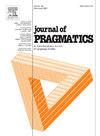汉语反语的翻译:韵律和熟练程度在汉语第二语言学习者中的作用
IF 1.7
1区 文学
0 LANGUAGE & LINGUISTICS
引用次数: 0
摘要
本研究探讨了二语语用学和韵律学的交集,重点研究了第二语言汉语学习者通过韵律解读讽刺意图的能力。反讽作为一种非文字的语言形式,其翻译依赖于韵律等线索。对于二语学习者来说,识别这些韵律线索对于消除歧义和避免交际中断至关重要。该研究采用横断面设计,包括中级(n = 29)和高级(n = 23) L1美国英语使用者学习普通话作为第二语言,以及母语为汉语的人(n = 60)。参与者完成了一项实验性口译任务,旨在评估熟练程度和韵律对口译说话者意图的影响。刺激包括三种韵律语调的话语:讽刺、热情和中性。结果表明,熟练程度提高了学习者通过韵律解读反语的能力,高水平学习者的表现优于中级学习者。高级学习者对讽刺语气表现出更大的敏感性,而中级学习者更多地依赖于字面意义,而忽略了韵律线索。这些发现突出了二语学习者语用韵律能力的发展轨迹,并为未来的教学实践提供了启示。本文章由计算机程序翻译,如有差异,请以英文原文为准。
Interpreting verbal irony in Mandarin Chinese: The role of prosody and proficiency among L2 learners of Chinese
This study examines the intersection of second language pragmatics and prosody, focusing on L2 Chinese learners' ability to interpret ironic intentions through prosody. Irony, as a form of non-literal language, relies on cues such as prosody for interpretation. For L2 learners, recognizing these prosodic cues is crucial to disambiguating meaning and avoiding communicative breakdowns. The study employs a cross-sectional design, including intermediate (n = 29) and advanced (n = 23) L1 American English speakers learning Mandarin as a second language, as well as native Chinese speakers (n = 60). Participants completed an experimental interpretation task designed to assess the impact of proficiency and prosody on interpreting speakers' intentions. Stimuli included utterances delivered in three prosodic tones: ironic, enthusiastic, and neutral. Results showed that proficiency enhanced learners' ability to interpret irony through prosody, with advanced learners outperforming intermediate learners. Advanced learners showed greater sensitivity to ironic tones, while intermediate learners relied more on literal meanings and overlooked prosodic cues. These findings highlight the developmental trajectory of L2 learners’ pragma-prosodic competence, and shed light on future pedagogical practice.
求助全文
通过发布文献求助,成功后即可免费获取论文全文。
去求助
来源期刊

Journal of Pragmatics
Multiple-
CiteScore
3.90
自引率
18.80%
发文量
219
期刊介绍:
Since 1977, the Journal of Pragmatics has provided a forum for bringing together a wide range of research in pragmatics, including cognitive pragmatics, corpus pragmatics, experimental pragmatics, historical pragmatics, interpersonal pragmatics, multimodal pragmatics, sociopragmatics, theoretical pragmatics and related fields. Our aim is to publish innovative pragmatic scholarship from all perspectives, which contributes to theories of how speakers produce and interpret language in different contexts drawing on attested data from a wide range of languages/cultures in different parts of the world. The Journal of Pragmatics also encourages work that uses attested language data to explore the relationship between pragmatics and neighbouring research areas such as semantics, discourse analysis, conversation analysis and ethnomethodology, interactional linguistics, sociolinguistics, linguistic anthropology, media studies, psychology, sociology, and the philosophy of language. Alongside full-length articles, discussion notes and book reviews, the journal welcomes proposals for high quality special issues in all areas of pragmatics which make a significant contribution to a topical or developing area at the cutting-edge of research.
 求助内容:
求助内容: 应助结果提醒方式:
应助结果提醒方式:


